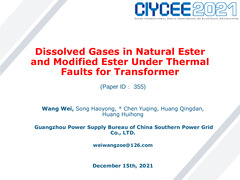Dissolved Gases in Natural Ester and Modified Ester under Thermal Faults for Transformer
ID:233
Submission ID:355 View Protection:ATTENDEE
Updated Time:2021-12-10 13:33:10
Hits:771
Oral Presentation

Start Time:2021-12-17 10:30 (Asia/Shanghai)
Duration:15min
Session:[D] High voltage and insulation technology » [D6] Session 34
Video
No Permission
Presentation File
Tips: The file permissions under this presentation are only for participants. You have not logged in yet and cannot view it temporarily.
Abstract
Abstract -- With increasing attention to environmentally friendly characteristics of power transformer insulating liquid, natural ester, synthetic ester and modified ester have gradually become alternative insulating liquids for transformers. Owing to the lack of data on dissolved gases in natural and modified esters for transformer, this study presents experimental results on dissolved gases in natural and modified esters under typical thermal faults. The experimental results show that the content and proportion of dissolved gases in different types of insulating liquids under the same thermal fault simulation are different due to the differences in their chemical compositions. Furthermore, to better explain the law of gas generation and the process of degradation, gassing behavior, neutralization titration, ultraviolet-visible spectroscopy, and infrared spectroscopy have been used to analyze the influence of thermal faults on insulating liquids. It can be concluded that the natural and modified ester produce acids, aldehydes, and other compounds under thermal faults, and the decomposition pathways of these products are different for natural and modified esters, For the diagnosis of power transformer thermal faults, different criteria are needed.
Keywords
Decomposition pathway, dissolved gas analysis, natural ester, modified ester, thermal faults
Speaker




Comment submit